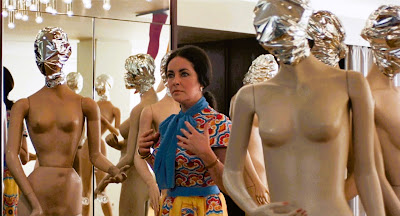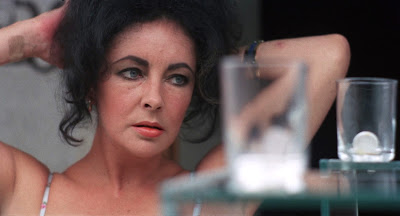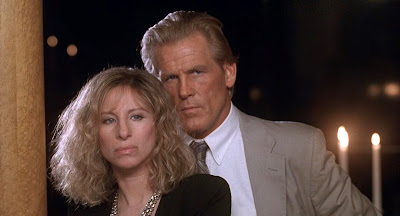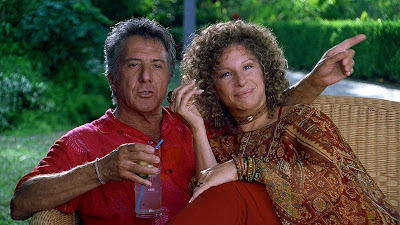Spoiler Alert: Crucial plot points are revealed in the interest of critical analysis and discussion
 |
| Elizabeth Taylor as Lise |
.jpg) |
| Ian Bannen as Bill |
 |
| Mona Washbourne as Mrs. Helen Fiedke |
 |
| Andy Warhol as The English Lord |
.jpg) |
| Guido Mannari as Carlo the Mechanic |
 |
| Maxence Mailfort as Pierre The Right Type |
The Driver’s Seat (alternate title: Identikit) is a dreamlike, metaphysical grim fairy tale whose non-linear narrative—in its recounting—sounds a little like a collaboration between Edgar Allan Poe and David Lynch. This visually distinguished Italian production casts a game Elizabeth Taylor (during her quirky, art film phase) as Lise, a raven-haired Goldilocks who visits Rome on a determined quest to find a man who is not too hot, not too cold, but “just right” to serve as her Dark Destiny escort.
Whereas Goldilocks’ curiosity led her to three domesticated bears, Lise’s schizophrenia-fueled search for her Wizard of Odd merely yields three unmitigated bores: one ideologically overbearing (Ian Bannen), the other sexually assaultive (Guido Mannari), and the third, empathetically apathetic (Andy Warhol).
But like Joseph in the Bible—the one who also favored the conspicuous masquerade of a coat of many colors—Lise, whose name means “Pledged to God,” isn’t one to let a few setbacks and disappointments shake her faith in the incorruptible purity of her morbid pilgrim’s progress.
Every detail of Lise’s journey is planned to be just so. She purchases a violent paperback novel (The Walter Syndrome by Richard Neely, a 1970 thriller about a serial killer) and throughout her trip, holds it in front of her like an airport greeter.
As is the wont of fairy tales, Lise is assisted on her journey by a Fairy Godmother figure (Mona Washbourne) who supplies the crucial athame for Lise’s tryst of fate with her (literal) “man to die for.” It’s also traditionally fitting that through her guidance, Lise comes to the Dorothy Gale-esque realization that the very thing she has been searching for so intently, has been there all along, right under her nose, the entire time.
 |
| Getting to the Point "It's in my mind, and I can't think of anything else but that you and my nephew were meant for each other." |
A movie as confounding as it is compelling, The Driver’s Seat is based on the 1970 novella of the same name by author Muriel Spark (The Prime of Miss Jean Brodie). Spark, who considered The Driver’s Seat to be her best-written novel, labeled the book a “whydunnit” murder mystery because the story begins in the middle (Lise’s madness is already full-blown...we know not its source or duration, only that she has reached the end of her tether) and calls on the reader to disregard the story’s openly divulged victim and killer, concerning themselves instead with the motive.
Easier said than done.
The Driver’s Seat is a mesmerizingly loopy movie that, while leaving me with more questions than answers, is imbued with such a poignant air of despairing sadness that it impressed me as something of a distaff Death in Venice. Which brings me to note that thus far in this essay, I’ve been being needlessly coy about something the novel reveals right off the bat: that Lise—in a perverse distortion of the fairy tale trope of the heroine waiting to be rescued by the idealized man—is searching for the perfect man to kill her.
As a damsel in emotional distress who’s more desirous of release than rescue, Lise is staunch in her belief that the right man will “Recognize me for the woman that I am right away,” but is willing to leave only so much to chance. To speed things along and better facilitate the precise outcome she seeks, it’s necessary for Lise, like a Grim Reaper Dolly Levi, to be a woman who arranges things.
Indeed, in taking the driver’s seat and micromanaging her predestined demise with the fastidious attention to detail of an overconscientious party planner, Lise, in this identity-crisis puzzler, assumes the identity of both murderer and victim.
.jpg) |
| Mrs. Fiedke- Will you feel a presence? Is that how you'll know? Lise- Not really a presence. A lack of absence. That's what it is. |
WHAT I LOVE ABOUT THIS FILM
Directed and written with idiosyncratic assurance by Guiseppe Patroni Griffi (screenplay co-written by Raffaele La Capria), The Driver’s Seat is a dark (occasionally darkly comic) and melancholy portrait of a woman well past the verge of a nervous breakdown.
Faithfully adapted from Spark’s oblique novella, the filmmakers have crafted an equally abstruse, illusory film that combines elements of a road movie (Lise’s journey being both literal and psychological), murder mystery (again, the why, not the who), and character study (everything that’s not presented as part of a police investigation into events that have yet to occur, is seen from Lise’s point of view). Along the way, The Driver’s Seat toys with concepts of perception-interpretation/identity-self as they relate to one of my longstanding favorite “human condition” themes: emotional alienation and the innate need to forge a connection with others.
Our introduction to Lise is abrupt and totally lacking in qualifiers. First, encountered mid-argument with a saleswoman over a stain-resistant dress: “Do I look like the kind of person who spills things on my clothing?”… then Medusa-maned and mascaraed within an inch of her life as she embarks upon her gloomy Roman Holiday dressed like a color TV test pattern.
The film takes the novel’s starts-in-the-middle story and future-intrudes-upon-the-present narrative structure and translates it into a deliberately fragmented, disorienting cinematic style that forces the audience to filter reality through Lise's alternatingly distracted/laser-focused gaze. Potentially mirroring Lise’s intensifying sense of isolation, the vision of the world we’re given feels lacking in warmth, subtly hostile, and ever on the brink of some sudden outbreak of violence. In this paranoid landscape of shadowy faces and elliptical conversations, everything and everyone feels just a little bit off.
Not the least, Lise herself, who, when her eccentrically flamboyant appearance isn’t drawing stares, eliciting giggles, or the haughty disdain of near-identical coil-coiffed salesgirls, moves about in an almost trancelike haze.
It’s ultimately revealed that there is a method behind Lise’s behavioral madness and that everything from her provocative appearance (we've seen that in her day-to-day life she dresses very conservatively) to her attention-getting conduct is calculated for deliberate effect. She’s seeking to make an impression, to leave a mark, to be remembered, to be identified. An attempt, conceivably, to achieve in death something she lacked in life.
The Driver's Seat was released as Identikit everywhere but in the US. An Identikit is a system of criminal identification that collects facial feature details from witness descriptions and combines them to create a composite portrait of the individual they are seeking.
The Driver's Seat narrative unfolds in a time-warp fashion, with Lise and the Italian police engaged in a simultaneous, dual manhunt. Both are in search of a killer, Lise before, and the police after.
THE STUFF OF FANTASY
The first time I became aware of The Driver’s Seat was in 1973 (was I the only kid who read Weekly Variety in high school?). At the time, Taylor and Burton were in the throes of the first of their eventual two divorces, so despite Taylor’s comparative irrelevance vis-à-vis the New Hollywood, both she and the film were generating plenty of publicity traction. With Glenda Jackson, Jane Fonda, Karen Black, and Faye Dunaway crowding my movie infatuations back then, Elizabeth Taylor was more a gossip magazine stalwart and movie star for my parents than an actress I paid much attention to.
Taylor had been effectively off my radar since 1968’s Secret Ceremony (which would make a great double bill with The Driver’s Seat, by the way), but my interest was reignited when she starred in the surprisingly effective mystery thriller Night Watch (1973). When I read that the forthcoming The Driver’s Seat (made between the movies Ash Wednesday and The Bluebird) was also to be a thriller, I was seriously stoked and eagerly anticipated its release.
But like several other ‘70s releases that pinned their hopes on the Nostalgia Craze appeal of faded-luster Classic Hollywood (Mae West’s Sextette; Billy Wilder’s Fedora; Marlene Dietrich and Kim Novak in Just A Gigolo), The Driver’s Seat opened in theaters with all the fanfare of an ex-mobster entering the witness protection program. Despite Elizabeth Taylor’s star power, The Driver’s Seat (Taylor’s first completely foreign-made film) struggled to get American distribution and was barely shown outside of a handful of major cities. In fact, it wasn’t released in my neck of the woods (San Francisco) until 1978, by which time I had graduated from high school and moved to Los Angeles.
For the longest time The Driver’s Seat existed as one of those movies more talked about than actually seen. And, as so often happens in such cases, its unavailability gave it a cult cachet. When I finally saw it in the mid-to-late ‘80s (a VHS rental, I think), The Driver’s Seat had earned the reputation of being one of Taylor’s so-bad-it’s-good camp-fests, surpassing even BOOM! (1968) in outlandishness.
Armed with little else to go on, that's the perspective through which I approached it and enjoyed it. But as I’ve learned in the years since—after several revisits and reading the novella—watching The Driver’s Seat exclusively through the prism of its arthouse camp appeal is like not really seeing it at all.
 |
| Nothing goes well for Lise when she's not in the driver's seat |
If the tenets of camp embrace artifice, stylistic excess, and a preoccupation with offbeat sex, then The Driver’s Seat more than qualifies for the classification. With its dialogue that wouldn’t sound out of place in Beyond the Valley of the Dolls: “When I diet, I diet. When I orgasm, I orgasm. I don’t believe in mixing the two cultures,”; Neely O’Hara-suitable outbursts: (Lise) “Well then, don’t just stand there staring at me like a chicken with one eye! Help me!”; and scenes of Taylor writhing around on a bed clutching her breasts, or Andy Warhol popping up like he’s en route to his Love Boat cameo, 12 years early…there’s no denying that The Driver’s Seat can be a delightfully kitschy howl.
I've never been sure if the bandage on Lise's left wrist is a character clue related to what was briefly disclosed early in the film regarding her history of mental illness, or merely evidence of the famously accident-prone actress' latest mishap.
But I contend—and this goes back to my interpreting the movie as something of a fractured fairy tale about a lonely and unbalanced woman’s romantic obsession with death—that The Driver’s Seat is such an unusual, even impenetrable story told with so few narrative guardrails that responding to it purely as camp was just the easiest, most entry-level route of access for me (laughter often being the go-to when one is confused or made uncomfortable by something ). But when I stopped trying to laugh at The Driver’s Seat, it surprised me how much I was moved and disturbed by it.
 |
| Lise- I feel homesick. Bill- Homesick for what? Lise- My loneliness. I want to go back home to feel all my loneliness again. |
Okay, I admit it. That exchange gave me waterworks.
PERFORMANCES
While the results of her efforts tended to vary significantly, I nevertheless have to hand it to Elizabeth Taylor for not taking the predictable career path her global motion picture celebrity afforded. She could easily have gone on churning out formulaic, commercially successful potboilers like The Sandpiper and The V.I.Ps, but throughout the late '60s and ‘70s, she instead pursued daring, unconventional roles in often aggressively offbeat films.
I rank Elizabeth Taylor’s performance in The Driver’s Seat as one of her most emotionally resonant of this period, especially in the film’s latter third. It's then that the heretofore performative aspects of Lise’s madness grow more internal, evoking a weary despondency that’s truly heartbreaking.
But paradoxically speaking, while I think Taylor is definitely the best thing in the film and its principal driving force (see what I did there?), I also think she’s its biggest liability—or rather, her inescapable Taylor-ness is. The Driver’s Seat is one of my favorite ‘70s films, capturing the darkness of Nixon-era nihilism, post-Women’s Lib uncertainty, and “Me Era” selective self-delusions. But how accessible can any of this be when the most significant obstacle anyone watching The Driver’s Seat is faced with is trying to forget you’re watching Elizabeth Taylor?
I'd read that at one time, director Luchino Visconti had once hoped to make The Driver’s Seat with Glenda Jackson. Oh, my God! Jackson's casting would have been ideal, what with her talent and no-nonsense gravitas making the film easily imaginable as a totally camp-free experience (as much as a Visconti film can be divested of camp, I suppose). While I'm sure Taylor's participation was integral to financing and getting the film green-lit, I can't help but mourn the subtleties lost. Take, for example, the dramatic significance of Lise's adoption of such a luridly flashy appearance for her sojourn in Italy. Signaling as it does Lise's identity crisis and mental disintegration, its impact was considerably defanged by the fact that by the 1980s--when I saw it---Taylor had adopted this very look as her personal style during her José “Shake your head, darling!” Eber, big hair, big-makeup period.
Documents in the Muriel Spark Archives at the National Library of Scotland reveal that the author was happy with the casting of Elizabeth Taylor, and the two exchanged Mutual Admiration Society letters before production began.
In later years, Spark has maintained that she thinks Taylor did a good job in the film, only that she was perhaps miscast: “Elizabeth Taylor was very good, but she looked too healthy to be the neurotic girl.
There was no way in which Elizabeth Taylor could look as if she wanted to die. She looked as if she wanted to drink.” Muriel Spark - SF Examiner May 21, 1986
 |
| It's unclear whether Lise is pursuing or following her destiny, but I love how the film signifies her being on the right path by its use of a glowing orb of light. |
THE STUFF OF DREAMS
Dangerous Women.
Lise’s last words in The Driver’s Seat are “Kill me!” Gloria’s (Jane Fonda) last words in They Shoot Horses, Don’t They? are “I’m ready.” Theresa’s (Diane Keaton) last words in Looking for Mr. Goodbar are “Do it!”
Was this a trend or something? I kinda think so.
To me, these films, with their tragically bleak conclusions, form a trilogy that encapsulates the male-centric New Hollywood's perception of what I call the 'Dangerous Woman.' This character, a contemporary, post-The Feminine Mystique iteration of the disillusioned Angry Young Man of ‘50s New Wave cinema, is seen as a threat to the established order, and her only 'out' or 'Happy Ending' is often depicted as self-destruction.
What connects The Driver’s Seat to They Shoot Horses, Don’t They? and Looking for Mr. Goodbar is that they are all about women…angry, frustrated, or rebellious women…who, for one reason or another, have reached the frayed end of what Alexandre Dumas called “the slender thread” by which life and fortune hang.
Movies in the '70s gave us literal armies of angry, disillusioned, and rebellious men who were perceived to be heroic in their discontent. Not so much with women.
Female characters embodying the same disillusionment were viewed differently onscreen. Maybe because there are audiences, male and female alike, who can identify with the male desire to stick it to "The Man" easier than they can get behind a woman sticking it to "Men" in general.
I like to think that the time has passed when death is seen as the only recourse and outcome for cinema’s 'Dangerous Women.' But provocatively, in this day and age where the fundamental human right of body autonomy is still a debated subject, it gives me food for thought to ponder how The Driver’s Seat presents Lise’s suicide (or assisted suicide, if you will)—the kind of act traditionally associated with the loss of control—as something so controlled and plotted that it takes on an air of self-actualization. As though Lise is exercising the only power she may feel she has, the power to do with herself as she pleases. The ultimate exercising of her right to choose. Even if it's death.
And if that doesn't sound like a Grim(m) Fairy Tale, I don't know what does.
 |
| Into The Woods |
BONUS MATERIAL:


In 2015, The National Theater of Scotland staged a theatrical version of The Driver's Seat adapted and directed by Laurie Sansom. Starring Morven Christie as Lise.


.jpg)





.jpg)



.jpg)




.jpg)






.JPG)






.png)






.JPG)










